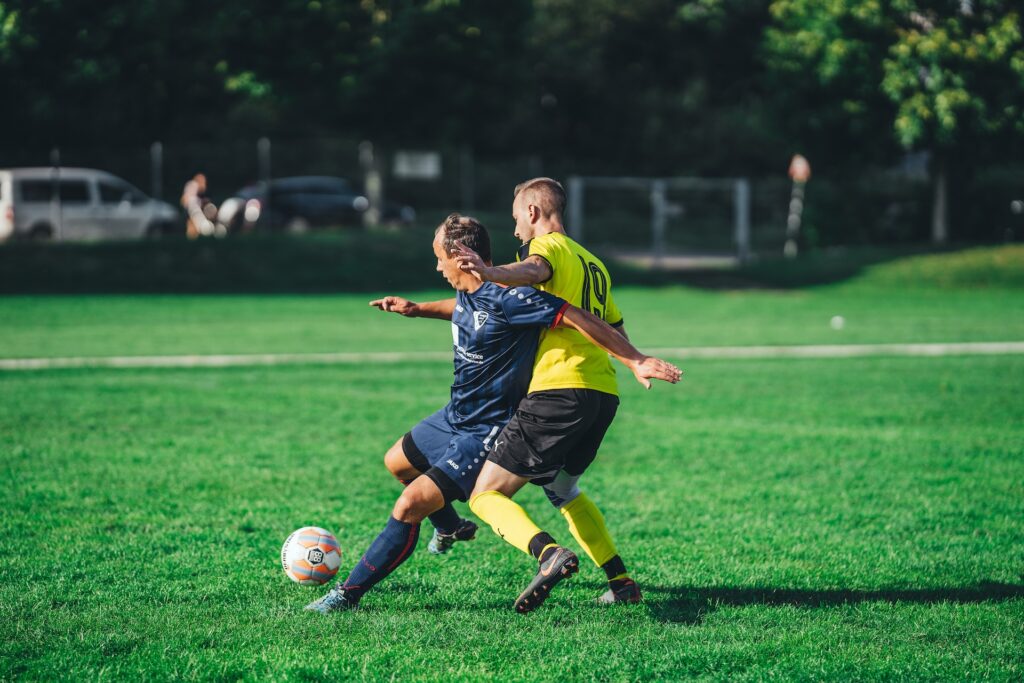Table of Contents
- What is the obstruction rule in soccer?
- How to commit obstruction in soccer?
- What is the punishment for obstruction in soccer?
- Is obstruction a good tactic for time wasting?
- How to win the ball off a player obstructing it?
- How to avoid obstruction in soccer?
- Recap: Obstruction in soccer explained
While soccer is a contact sport, it’s important to remember and remind ourselves what constitutes a foul and what doesn’t.
The game isn’t quite as physical as it once was, but the obstruction rule still stands, despite holding having no contact involvement whatsoever. You might be scratching your head, wondering what in fact the obstruction rule is.
Well, Soccer Knowledge Hub is here to explain in full what exactly this rule is, why it exists in the game, and how the law is applied.
What is the obstruction rule in soccer?
The obstruction rule is when one player impedes the run or path of another player intentionally without any contact being made.
Importantly, it’s only considered obstruction when the ball is nowhere near either player involved. If the ball was nearby, blocking or slowing down your opponent would be deemed acceptable.
The rule has been around for a long time but has undergone name changes and tweaks to its details. In fact, the very term ‘obstruction’ was omitted from FIFA’s wording in the late 90s, instead replaced with “impeding the progress of an opponent”.
In essence, the rule is basically the same but the language is more understandable to fans, officials, and players alike. The term obstruction had been misconstrued over the years and FIFA felt the new language was easier to interpret.
How to commit obstruction in soccer?
Let’s use an example: if a player is sprinting into the penalty area because a teammate of theirs is in a good crossing position, a defender clearly cutting across their path to impede their run would be considered obstruction.
Defenders are more than entitled to make their own run toward the ball or the area they believe the ball will be delivered into, of course, but it can’t infringe upon the actions of a running opponent.
As the English FA puts it in their interpretation of the laws: “being in the way of an opponent is not the same as moving into the way of an opponent”.
What is the punishment for obstruction in soccer?
When an obstruction occurs, an indirect free kick is awarded. This means that the free-kick taker isn’t allowed to shoot directly at the goal and must instead feed it to another player before the ball enters the net.
This is different from most other fouls in the game where a direct free kick would be awarded.
It’s important to stress that a penalty can’t be awarded for obstruction. This is because it is neither a handball nor a contact infringement – these types of fouls would indeed result in a penalty being awarded.
As it is outside the area, an indirect free kick would be awarded in the penalty area if an obstruction incident occurs. The same rules apply to the indirect free kick inside or outside the penalty area and the defending team would still need to be the same distance away from the ball (unless the indirect free kick is within 10 yards of the goal line, in which case the opposition players must line up on the goal line itself).
Is obstruction a good tactic for time wasting?
Many fans believe, incorrectly, that shielding the ball near the corner flag with your body so it’s difficult for the opposition to get contact with it is obstruction. However, because the players involved are near the ball’s vicinity, this act is not deemed as obstruction.
Your manager may well advise that you hold the ball near the corner flag of the opposition’s goal if your side is winning by a goal and is desperate to hold on to that lead. Of course, you risk giving away a free kick if things get overly physical, but the manager might feel this is a small price to pay for wasting valuable stoppage time in a crucial game.
Other managers might feel that it lacks sportsmanship to waste time, wanting integrity in their side. It can be a huge annoyance for fans to see players time wasting; ultimately, the game is supposed to be about entertainment, but we must remain aware of the cut-throat business nature in modern soccer.
There aren’t truly many forms of obstruction that will result in successful time-wasting, though, so it might be a fruitless task to run down the clock in this manner.
How to win the ball off a player obstructing it?

An obstruction can’t occur if the ball is near both players involved. Any illegal incident would be determined as a different type of foul, or it would be allowed to continue as fair play.
If a player is obstructing your path to the ball in the distance and the referee is not awarding an indirect free kick to your team in this instance, there are other ways to try and regain possession.
You can double up on that player, which means you and a teammate both try to retrieve the possession from different angles. It would be much more difficult for obstructing players to block both of your paths to the ongoing action.
How to avoid obstruction in soccer?
Always making an attempt to go for the ball when making a challenge will prevent you from committing an obstruction offense.
Contact is allowed in soccer, but remember to only get physical if the ball is in your immediate vicinity. Otherwise, this will be deemed as a foul. Obstruction is a little different from this because it involves no contact being made, it’s purely a method of halting a player’s movement by illegally, but unforcefully, hindering their progress.
While obstruction and physically jostling with another player have similar outcomes (both resulting in free kicks), they are defined as different fouls.
Recap: Obstruction in soccer explained
If the ball is near both players, then the referee is within their rights to allow play to go on until a physical foul is committed.
An incident will be classified as obstruction if a player is block from making a move when the ball is out of the vicinity entirely.
Knowing these distinctions can make the game an even more enjoyable experience and we hope that you are better informed when watching your next soccer match.

